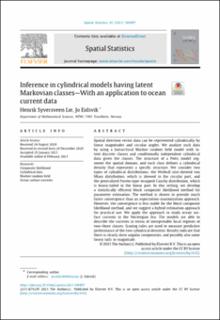| dc.contributor.author | Lie, Henrik Syversveen | |
| dc.contributor.author | Eidsvik, Jo | |
| dc.date.accessioned | 2021-04-15T12:35:37Z | |
| dc.date.available | 2021-04-15T12:35:37Z | |
| dc.date.created | 2021-04-12T13:27:16Z | |
| dc.date.issued | 2021 | |
| dc.identifier.citation | Spatial Statistics. 2021, 41, . | en_US |
| dc.identifier.issn | 2211-6753 | |
| dc.identifier.uri | https://hdl.handle.net/11250/2737939 | |
| dc.description.abstract | Spatial direction vector data can be represented cylindrically by linear magnitudes and circular angles. We analyze such data by using a hierarchical Markov random field model with latent discrete classes and conditionally independent cylindrical data given the classes. The structure of a Potts model segments the spatial domain, and each class defines a cylindrical density that represents a specific structure. We consider two types of cylindrical distributions; the Weibull sine-skewed von Mises distribution, which is skewed in the circular part, and the generalized Pareto-type wrapped Cauchy distribution, which is heavy-tailed in the linear part. In this setting, we develop a statistically efficient block composite likelihood method for parameter estimation. The method is shown to provide much faster convergence than an expectation–maximization approach. However, the convergence is less stable for the block composite likelihood method, and we suggest a hybrid estimation approach for practical use. We apply the approach to study ocean surface currents in the Norwegian Sea. The models are able to describe the currents in terms of interpretable local regimes of two–three classes. Scoring rules are used to measure predictive performance of the two cylindrical densities. Results indicate that there is clearly skew angular components, and possibly also some heavy tails in magnitude. | en_US |
| dc.language.iso | eng | en_US |
| dc.publisher | Elsevier Science | en_US |
| dc.rights | Navngivelse 4.0 Internasjonal | * |
| dc.rights.uri | http://creativecommons.org/licenses/by/4.0/deed.no | * |
| dc.title | Inference in cylindrical models having latent Markovian classes - with an application to ocean current data | en_US |
| dc.type | Peer reviewed | en_US |
| dc.type | Journal article | en_US |
| dc.description.version | publishedVersion | en_US |
| dc.source.volume | 41 | en_US |
| dc.source.journal | Spatial Statistics | en_US |
| dc.identifier.doi | https://doi.org/10.1016/j.spasta.2021.100497 | |
| dc.identifier.cristin | 1903533 | |
| dc.relation.project | Norges forskningsråd: 305445 | en_US |
| dc.description.localcode | This is an open access article distributed under the terms of the Creative Commons CC-BY license, which permits unrestricted use, distribution, and reproduction in any medium, provided the original work is properly cited. | en_US |
| dc.source.articlenumber | 100497 | en_US |
| cristin.ispublished | true | |
| cristin.fulltext | preprint | |
| cristin.qualitycode | 1 | |

